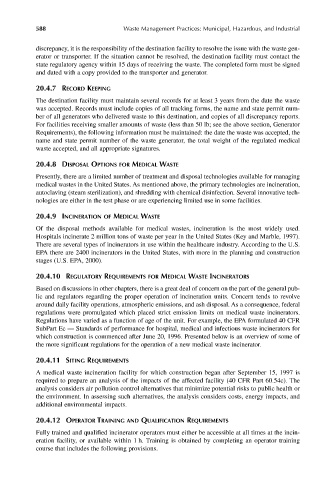Page 617 - Materials Chemistry, Second Edition
P. 617
CAT3525_C20.qxd 1/27/2005 12:54 PM Page 588
588 Waste Management Practices: Municipal, Hazardous, and Industrial
discrepancy, it is the responsibility of the destination facility to resolve the issue with the waste gen-
erator or transporter. If the situation cannot be resolved, the destination facility must contact the
state regulatory agency within 15 days of receiving the waste. The completed form must be signed
and dated with a copy provided to the transporter and generator.
20.4.7 RECORD KEEPING
The destination facility must maintain several records for at least 3 years from the date the waste
was accepted. Records must include copies of all tracking forms, the name and state permit num-
ber of all generators who delivered waste to this destination, and copies of all discrepancy reports.
For facilities receiving smaller amounts of waste (less than 50 lb; see the above section, Generator
Requirements), the following information must be maintained: the date the waste was accepted, the
name and state permit number of the waste generator, the total weight of the regulated medical
waste accepted, and all appropriate signatures.
20.4.8 DISPOSAL OPTIONS FOR MEDICAL WASTE
Presently, there are a limited number of treatment and disposal technologies available for managing
medical wastes in the United States. As mentioned above, the primary technologies are incineration,
autoclaving (steam sterilization), and shredding with chemical disinfection. Several innovative tech-
nologies are either in the test phase or are experiencing limited use in some facilities.
20.4.9 INCINERATION OF MEDICAL WASTE
Of the disposal methods available for medical wastes, incineration is the most widely used.
Hospitals incinerate 2 million tons of waste per year in the United States (Key and Marble, 1997).
There are several types of incinerators in use within the healthcare industry. According to the U.S.
EPA there are 2400 incinerators in the United States, with more in the planning and construction
stages (U.S. EPA, 2000).
20.4.10 REGULATORY REQUIREMENTS FOR MEDICAL WASTE INCINERATORS
Based on discussions in other chapters, there is a great deal of concern on the part of the general pub-
lic and regulators regarding the proper operation of incineration units. Concern tends to revolve
around daily facility operations, atmospheric emissions, and ash disposal. As a consequence, federal
regulations were promulgated which placed strict emission limits on medical waste incinerators.
Regulations have varied as a function of age of the unit. For example, the EPA formulated 40 CFR
SubPart Ec — Standards of performance for hospital, medical and infectious waste incinerators for
which construction is commenced after June 20, 1996. Presented below is an overview of some of
the more significant regulations for the operation of a new medical waste incinerator.
20.4.11 SITING REQUIREMENTS
A medical waste incineration facility for which construction began after September 15, 1997 is
required to prepare an analysis of the impacts of the affected facility (40 CFR Part 60.54c). The
analysis considers air pollution control alternatives that minimize potential risks to public health or
the environment. In assessing such alternatives, the analysis considers costs, energy impacts, and
additional environmental impacts.
20.4.12 OPERATOR TRAINING AND QUALIFICATION REQUIREMENTS
Fully trained and qualified incinerator operators must either be accessible at all times at the incin-
eration facility, or available within 1 h. Training is obtained by completing an operator training
course that includes the following provisions.

